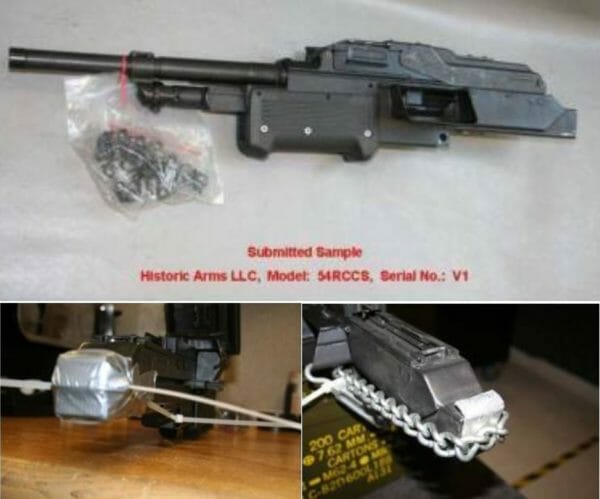
U.S.A. – -(Ammoland.com)- “Discovery in the above case rendered these gems of ATF groupthink … Imagine what the discovery is going be like in the trigger case????” Historic Arms LLC firearms designer Len Savage posted on an AR15.com thread talking about the Rare Breed Trigger case. “It will not be pleasant for ATF as I suspect their own internal emails will damn them.”
For those who have not been following that story, ATF issued a cease-and-desist order to Rare Breed Triggers over its FRT-15 Trigger, claiming it is a machinegun. The company says it will not comply with the order and has filed a lawsuit.
The previous case Savage was referring to was when ATF classified one of his submitted designs as a machinegun but had to make some major “modifications” to do it:
“ATF has a long history of using zip ties to make machine guns…See for yourself,” he wrote elsewhere in the thread, providing links to an ATF response letter revealing how they arrived at that conclusion, with the “help” of zip ties, duct tape, and chain.
This was a revelation of ATF “testing” procedures I first covered on my The War on Guns blog in 2008, presenting correspondence with ATF’s Firearms Technology Branch, and noting:
In addition to going through contortions to declare his property a machine gun and then refusing to return it, they’ve assigned his design submissions to an agent whose testimony Savage challenged.
Further detail was presented in my 2009 report after ATF arrested Savage’s submission. As I noted at the time:
With that criteria, given enough added parts that are not part of the submitted design, I know a lot of people who could turn a banana into a machine gun.
Because Savage chose to fight back – and to not hold back on how ridiculous he found ATF’s methods to be – and because that had been the way he had dealt with in-your-face ATF absurdities in other cases, it’s clear that retaliation and “getting” him back was the Bureau priority.
But don’t take my word for it. Take what’s been documented in ATF internal correspondence.
“FTB has received a response from Historic Arms,” John R. Spencer of the FTB informed his colleagues. “Mr. Savage has declined our offer to register his machinegun.”
“Let the fun begin,” Gary N. Schaible replied. As an aside, but for context, he’s the ATFer who had to provide testimonial cleanup in 1996 for the head of the National Firearms Act Branch after he was caught on videotape essentially admitting to institutional perjury:
“Let me say that when we testify in court, we testify that the database is 100 percent accurate. That’s what we testify to, and we will always testify to that. As you probably well know, that may not be 100 percent true.”
“I almost feel bad for that dude sometimes,” Violent Crime Analysis Branch’s Daniel L. Pinckney wrote about Savage in an email to NFA Branch Specialist Ernest A. Lintner. “Almost.”
As an aside, it’s clear from multiple emails that Pinckney bore a personal animosity to Savage, and from the tone of this and subsequent statements, it’s not unreasonable to infer an unfulfilled “You will respect my authoritah!” undercurrent going on.
“He is setting up a good case for a retaliation case though,” Pinkney had to admit. “The more he testifies as an ‘expert’ against ATF, and the more he gets hammered by FTB for anything he submits, the better his case gets for a civil suit at some point.”
“I wonder sometimes if we don’t ‘manufacture’ a firearm in the process of getting it to work,” Lintner acknowledged. “That is if someone in the public were to be caught with that rig, would we want them charged with manufacturing? I bet yes.”
“I remember seeing the pictures once before. I do think Len is an ass, and he deserves everything he has brought on himself, but if we/they have to stoop to that level to reject one of his projects, does it make us any better than him?” Pinckney responded, again showing personal hostility toward a citizen standing up for his rights against what the analyst knew, legally and morally, to be wrong. “If anything the zip ties, chain, and metal plate should be the illegal conversion device.
” [He actually ended his email with a smiley face icon.]
“I agree – if we alter course one way or the other based on who submits it, then the tail is wagging the dog – and in a case like this one manufacturer could use the agency to damage or wreck marketplace competitors,” Lintner replied.
“The emails shown are an internal commentary of what was going down,” Savage tells me. “Pickney and Lintner were equivalent to baseball commentators in that they were not playing the game or calling the shots, but they were reporting on the ball in play with color commentary.
“It shows the cold, callous math of folks who depend on the Department of Just-Us for a paycheck,” Savage notes. “They were just calling it as they saw it.”
It also shows how the “us vs. them” worldview results in a “team player” mentality and hostility toward “the other side,” even among functionaries not directly involved. It’s not hard to imagine those whose “professional judgments” are being publicly challenged, and whose careers can be affected by “losses,” are even more vested in winning at all costs (and resentful of vocal challengers).
Rare Breed Triggers’ Lawrence DeMonico has not been shy about standing up for himself in no uncertain terms, and in doing so has exposed the Bureau’s decision-making as political and worse. You can bet those he won’t just roll over for are taking that personally.
Savage is right. Discovery should produce some revealing examples of that.
About David Codrea:
David Codrea is the winner of multiple journalist awards for investigating/defending the RKBA and a long-time gun owner rights advocate who defiantly challenges the folly of citizen disarmament. He blogs at “The War on Guns: Notes from the Resistance,” is a regularly featured contributor to Firearms News, and posts on Twitter: @dcodrea and Facebook.

